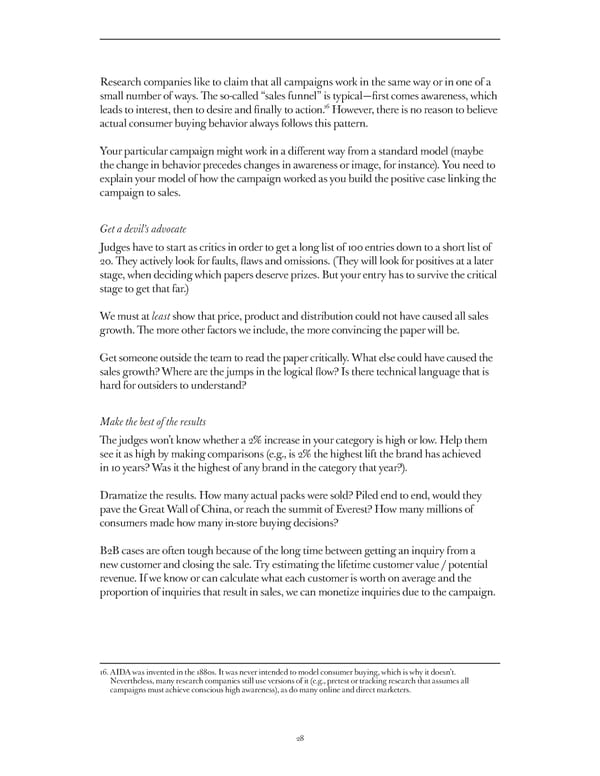Research companies like to claim that all campaigns work in the same way or in one of a small number of ways. The so-called “sales funnel” is typical — first comes awareness, which 16 leads to interest, then to desire and finally to action. However, there is no reason to believe actual consumer buying behavior always follows this pattern. Your particular campaign might work in a different way from a standard model (maybe the change in behavior precedes changes in awareness or image, for instance). You need to explain your model of how the campaign worked as you build the positive case linking the campaign to sales. Get a devil’s advocate Judges have to start as critics in order to get a long list of 100 entries down to a short list of 20. They actively look for faults, flaws and omissions. (They will look for positives at a later stage, when deciding which papers deserve prizes. But your entry has to survive the critical stage to get that far.) We must at least show that price, product and distribution could not have caused all sales growth. The more other factors we include, the more convincing the paper will be. Get someone outside the team to read the paper critically. What else could have caused the sales growth? Where are the jumps in the logical flow? Is there technical language that is hard for outsiders to understand? Make the best of the results The judges won’t know whether a 2% increase in your category is high or low. Help them see it as high by making comparisons (e.g., is 2% the highest lift the brand has achieved in 10 years? Was it the highest of any brand in the category that year?). Dramatize the results. How many actual packs were sold? Piled end to end, would they pave the Great Wall of China, or reach the summit of Everest? How many millions of consumers made how many in-store buying decisions? B2B cases are often tough because of the long time between getting an inquiry from a new customer and closing the sale. Try estimating the lifetime customer value / potential revenue. If we know or can calculate what each customer is worth on average and the proportion of inquiries that result in sales, we can monetize inquiries due to the campaign. 16. AIDA was invented in the 1880s. It was never intended to model consumer buying, which is why it doesn’t. Nevertheless, many research companies still use versions of it (e.g., pretest or tracking research that assumes all campaigns must achieve conscious high awareness), as do many online and direct marketers. 28
 A Guide To Effectiveness Page 27 Page 29
A Guide To Effectiveness Page 27 Page 29